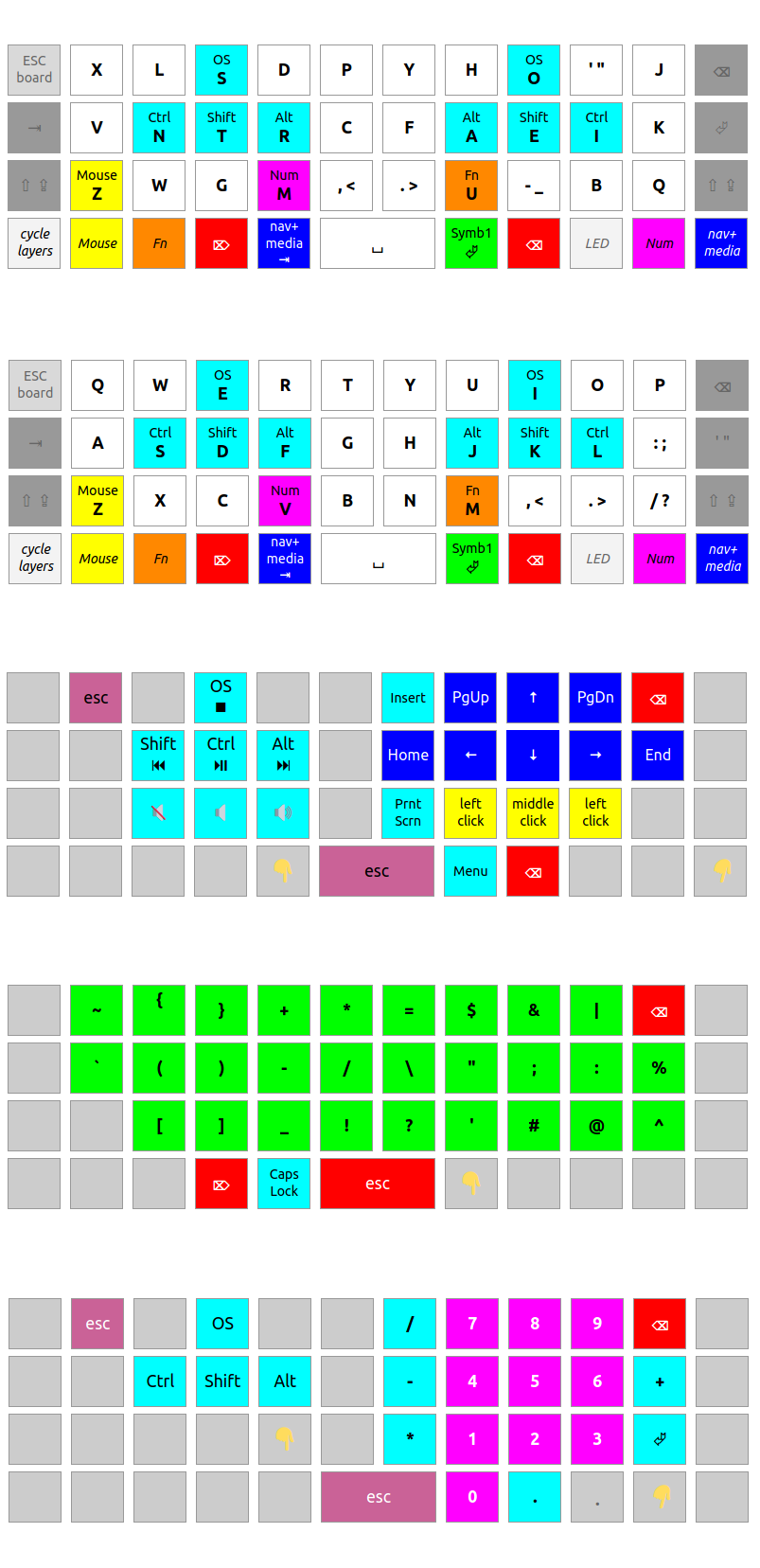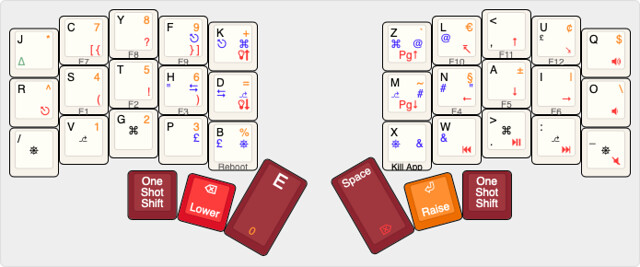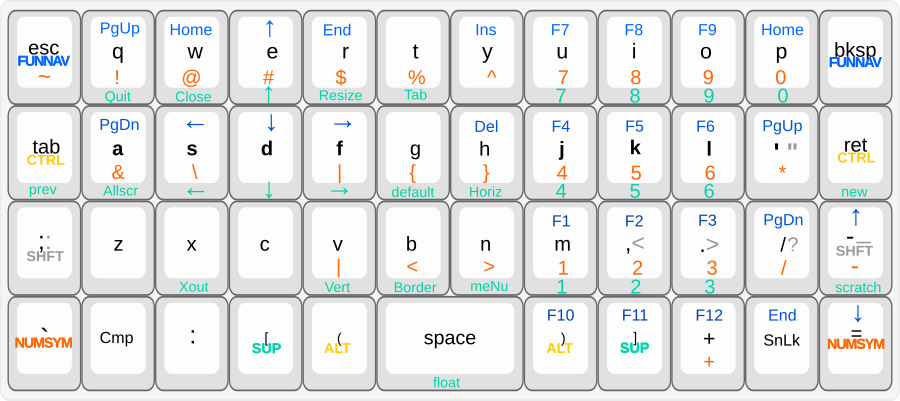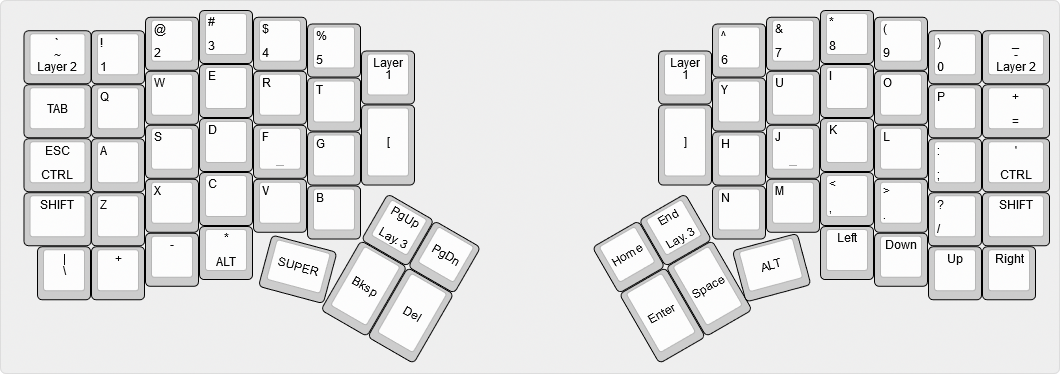Showing 109 to 126 of 142 results found.

36 keys
English
2 layers
Colemak
A keymap of my custom corne mini layout, which has 36 keys. It has a num layer which adds 27 more symbols, and then lots of combos for everything else. The combos make backspace, esc, and delete available from the home row, and everything else very close too! It's been awesome to use for both prose and coding!

34 keys
English
5 layers
Colemak
Seniply is an ergonomic, minimal keyboard layout for a keyboard with at least 34 keys. The minimum requirement is 30 keys in the main body plus 4 thumb-keys. All the features (and more) of a standard full-size keyboard are available by making use of six layers, which are activated via the thumb keys. The default base layer is Colemak-DH.

58 keys
English
4 layers
QWERTY
Taking the default keymap as my starting point, I started to tweak things almost immediately to fit my typing style and allow me to ease into a layout that isn't too far from a standard QWERTY keyboard. Build log available.

26 keys
English
9 layers
smallcat
The Smallcat is a minimalist keyboard with just 26 keys, designed to reduce finger strain and minimize movement—especially for the pinky fingers. To compensate for the limited number of keys, it relies heavily on combo inputs. Using very light switches is recommended, making the typing experience especially comfortable.

45 keys
English
6 layers
Dvorak, Colemak, QWERTY

50 keys
English, Spanish
10 layers
Colemak
Spanish/English focused for Tiling WM with heavy use of combos for symbols, layer for JetBrain's IDES and OS Switching for tilde usage for the vowels. Featuring TFT Display and a Cirque Trackpad to switch from mouse movements to scroll.

42 keys
English, Spanish
7 layers
Colemak
Miryoku-like layout for spanish/english programmers

18 keys
English
6 layers
StiFluQz
Half of a Microdox for one-handed typing.

33 keys
English, Italian, German
12 layers
Colemak
Very easy efficient three layer keymap based on Colemak-DH adjusted for Italian/German.

48 keys
English
9 layers
t00mietum, QWERTY
A bottom-up ergonomic redesign keyboard layout for QMK programmable keyboards. There were no sacred cows - not modifiers, not symbols ... only statistically validated and human-tested comfort.

36 keys
English
5 layers
QWERTY
This is a split, wireless-only mechanical keyboard. Include battery pads, power switches for wireless use, Displays

50 keys
English
7 layers
Colemak
A combo-based layout for Ergonomic Keyboards, implemented in QMK

47 keys
English
10 layers
QWERTY, Colemak, Dvorak
This layout takes advantage of as many QMK features as possible for a huge complicated beast of a keyboard!

76 keys
English
9 layers
RSTHD, QWERTY
The keymap of the creator of the RSTHD layout (xsznix), generated with his hand-rolled keyboard layout generation program called keygen, featuring the letter 'E' on the thumb key.

36 keys
English
4 layers
RSTHD
An attempt at porting Xuming Zeng’s RSTHD from the Ergodox to the Minidox, in a layout that favours prose rather than code, with symbols used in everyday writing such as various (Western) currencies in easy reach.

34 keys
English, Swedish
10 layers
RSTHD
T-34 is a 34 key layout that's focused on comfort and my personal usage patterns. I've written an article series where I document the revisions I make.

42 keys
English
4 layers
QWERTY
The ZeLDA (Zero-Look-Down Access) Layout is a minimalist approach to keyboarding. The philosophy is that you should never have to reach farther than one adjacent key. It's still a QWERTY, but seriously improved.

70 keys
English
4 layers
QWERTY
This keymap modifies the default keymap for the awesome Redox keyboard designed by Mattia Dal Ben. Also heavily inspired by nrichers's layout.















